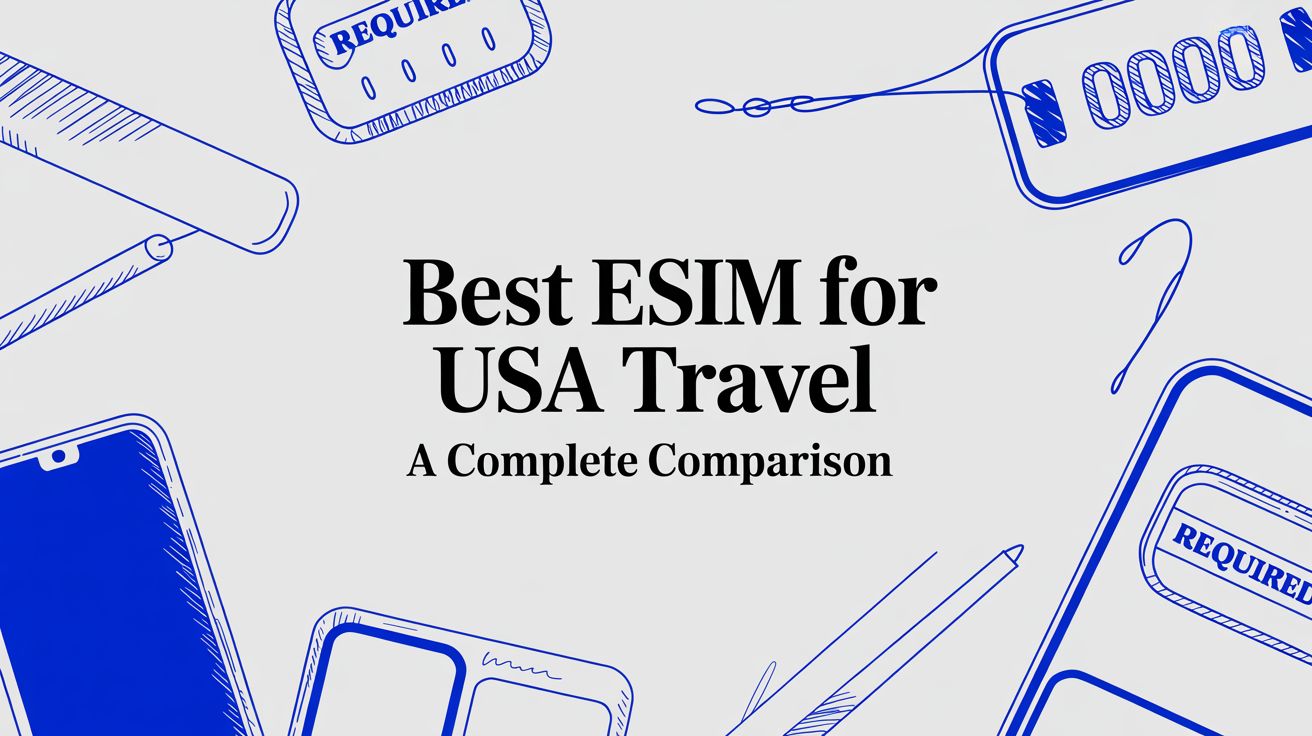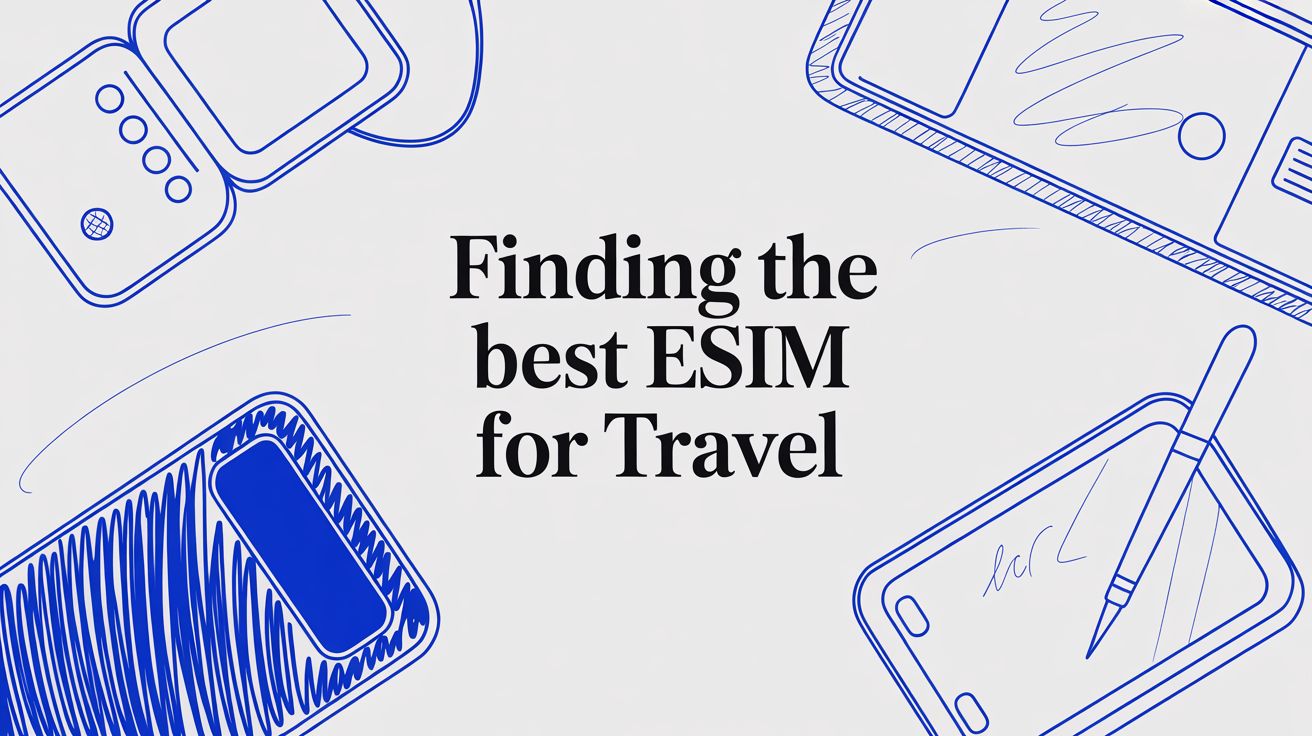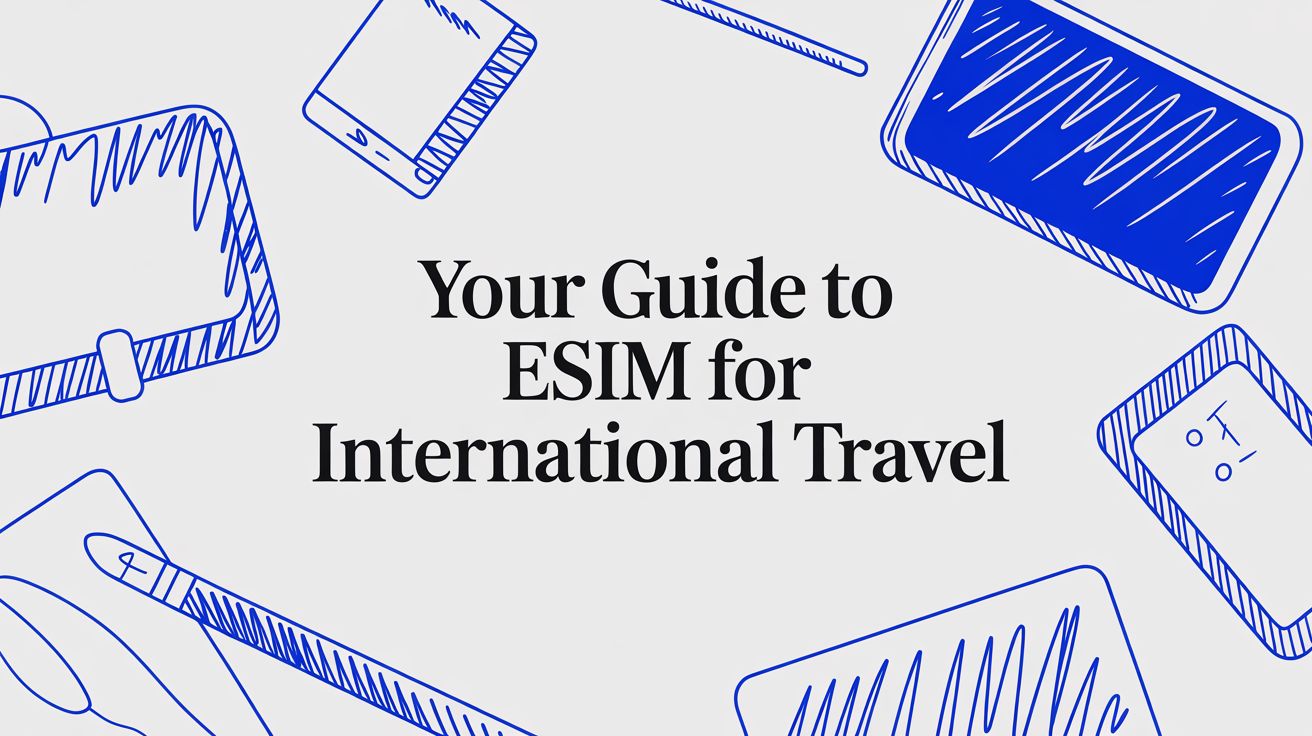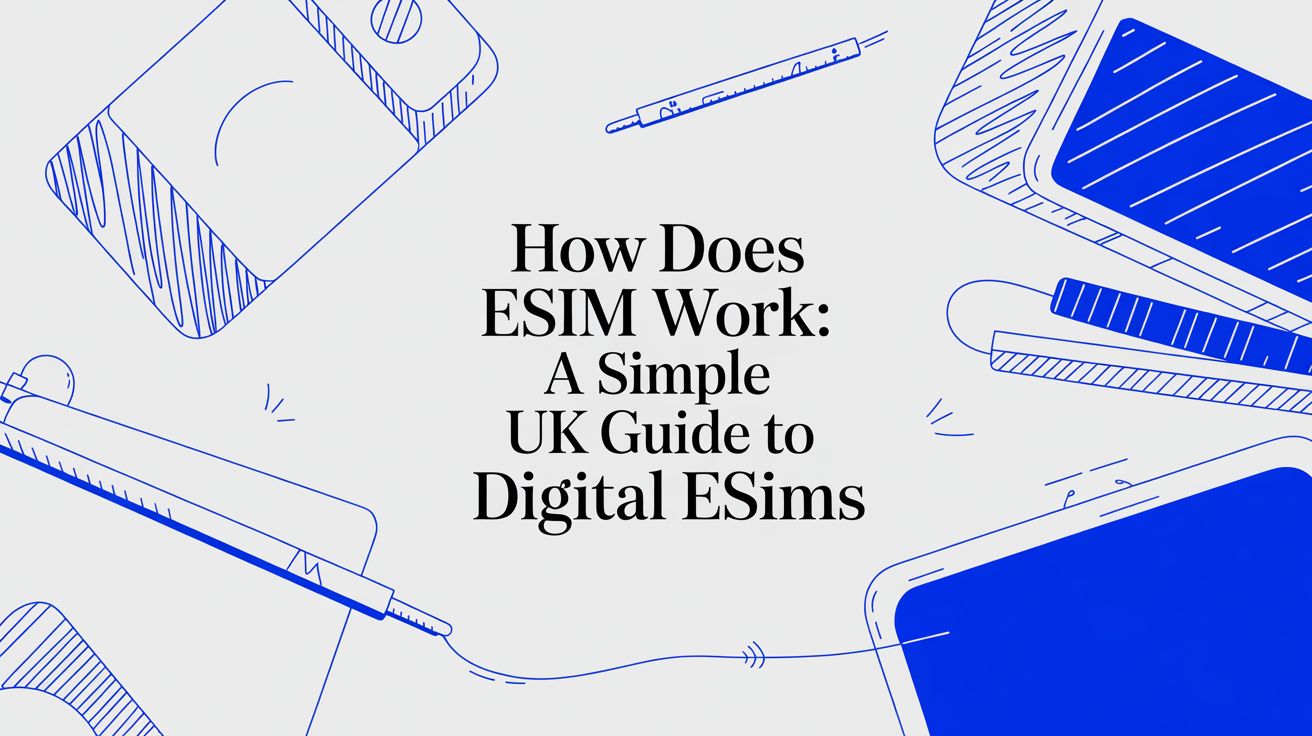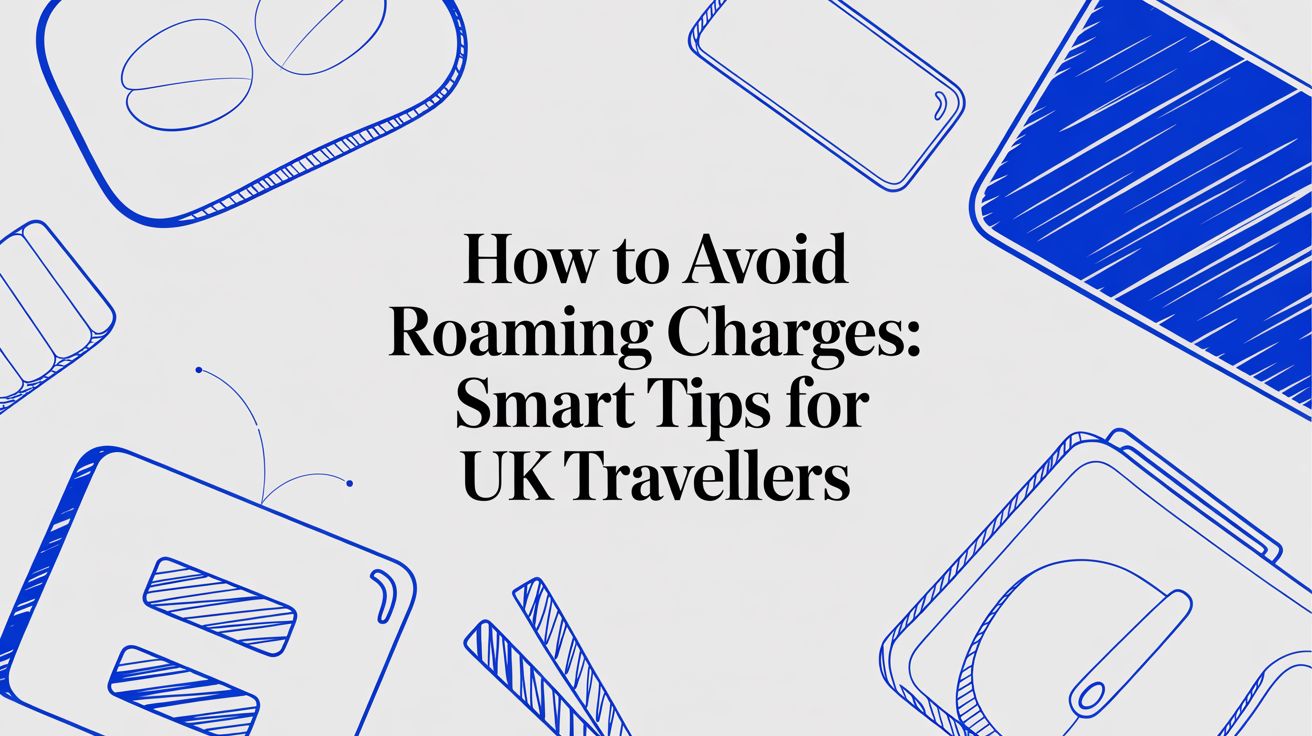

Choosing the right travel SIM for Europe usually boils down to one simple trade-off: convenience versus cost.Choosing the right travel SIM for Europe usually boils down to one simple trade-off: convenience versus cost. For most of us, an eSIM like TapSim is a lifesaver. You get instant activation and seamless coverage across multiple countries, which is perfect for a whirlwind tour.
However, if you’re planning a longer stay in just one country, a physical SIM from a local provider like Orange or Vodafone can sometimes snag you a bigger data bundle for your money.

Trying to figure out travel connectivity can feel like a chore, but it really comes down to a straightforward decision. You’re choosing between a modern eSIM (an embedded SIM) and a traditional physical SIM card. Each has its own strengths, and the best one for you depends on your phone, your travel plans, and how comfortable you are with the tech.
An eSIM is purely digital, letting you activate a mobile plan without faffing about with a tiny bit of plastic. The real magic here is that you can buy and set up your European data plan from your living room before you’ve even started packing. That kind of convenience is a total game-changer.
Then there’s the familiar physical SIM, that little chip you pop out of your phone. While it means you have to physically swap cards, it’s the only option for older phones and can sometimes offer really competitive deals from local European networks, especially if you’re staying put for a while. It’s no surprise that demand for flexible prepaid options skyrockets during peak travel seasons, a trend highlighted by industry analysis on platforms like accio.com.
To make things clearer, let’s quickly break down how these two stack up for a typical European getaway. This should give you a good idea of which route to take for your trip.
| Feature | Physical SIM Card | eSIM |
|---|---|---|
| Activation | You need to find a local shop on arrival or order one in advance and swap it in yourself. | Activation is instant via a QR code. You can be online in minutes, right after landing. |
| Device Swapping | Super easy. Just pop it out of one unlocked phone and into another. | Can be a bit trickier to transfer between devices once it’s activated. |
| Multi-Plan Use | Most phones only have one or two SIM slots, so you’re limited. | Lets you store multiple plans on your phone and switch between them as needed. |
| Best For | Travellers with older phones that don’t support eSIM, or anyone planning a long stay in one country. | Tech-savvy travellers, multi-country explorers, and anyone who wants instant connectivity without the hassle. |

Remember the frantic search for a SIM card kiosk the moment you landed in a new European city? Those days are pretty much over, and the technology responsible is the eSIM (or embedded SIM). It’s not a physical card you have to pop out; an eSIM is a small, rewritable chip that’s already built right into your phone.
This completely changes the game for staying connected abroad. Instead of fumbling with tiny bits of plastic, you just download and activate a data plan by scanning a QR code or through an app. This means you could be sitting in your flat in Manchester sorting out your data plan for a trip to Italy, and you’ll be online the second your plane touches down in Rome.
The UK travel market is rapidly embracing this shift, with travellers wanting connectivity that’s instant and flexible. In fact, some industry reports suggest that revenue from travel eSIM packages is expected to jump by 85% in 2025 alone. The UK eSIM market is growing fast, which tells you just how popular this hassle-free option has become.
One of the biggest wins for eSIMs on a European trip is the ability to have multiple plans on one phone. Picture this: you’ve got a plan for France, another for Switzerland (which often isn’t covered by standard EU roaming), and you can still keep your local number active for essential calls and texts. An eSIM makes this a reality, even without a physical dual-SIM phone.
This flexibility is brilliant for trips covering multiple countries. You can flick between a regional European plan and a country-specific one in your phone’s settings, making sure you’re always using the best-value network for where you are.
An eSIM gets rid of all the logistical headaches that come with traditional SIMs. You don’t have to worry about losing your tiny home SIM card or hunting for a paperclip to open the SIM tray. It’s simply a more secure, digital, and convenient way to handle your mobile data when you travel.
On top of that, the whole process is incredibly simple. You buy a plan online, and the provider emails you a QR code. Just scan it with your phone’s camera, and the installation kicks off, usually taking less than two minutes. To get a better feel for how it all works, you can learn more about what an eSIM is and how it functions in our detailed guide.
Before you jump in and buy a travel eSIM for Europe, it’s vital to make sure your phone actually supports the technology. Most modern flagship phones released in the last few years are good to go, including iPhones from the XS model onwards and recent Google Pixel and Samsung Galaxy devices.
Here’s a quick way to check:
Can’t find those settings? A quick search online for your phone model plus “eSIM support” will give you a clear answer. Confirming your device is ready is the first step to unlocking a much smoother way to stay connected on your travels.
Choosing the right travel SIM for Europe means looking past the flashy ads and getting into what actually matters when you’re on the ground. A provider might promise continent-wide coverage, but what does that really mean for your connection when you’re navigating the winding streets of Lisbon or trying to upload photos from a remote Swiss village? This comparison is all about digging into the practical, real-world differences between the leading options.
We’re going to break down network reliability across multiple countries, the actual 4G and 5G speeds you can expect, price transparency, and critical features like whether you can use your phone as a mobile hotspot. Getting these details right is the key to finding a provider that won’t let you down mid-trip. This is especially true for UK travellers, who are a huge part of the European travel scene.
In fact, individual consumers from the UK are set to make up a massive 67.2% of the travel SIM market share in 2025. This surge is driven by everything from the boom in international tourism to the rise of remote work and digital nomads, all creating a need for reliable, prepaid roaming. You can dive deeper into this trend by exploring the full research on travel SIM market dynamics.
The European travel SIM market has a few key players, each with its own game plan. Some, like Airalo, are all about choice, offering a massive variety of local and regional plans through a slick, user-friendly app. Others, such as Holafly, have built their brand around the seductive promise of “unlimited” data—perfect for travellers who want to stream and browse without constantly checking their usage.
Then you have providers like TapSim, which hang their hat on transparency and fair pricing, making sure you know exactly what you’re paying for without any nasty surprises.
The best choice really boils down to your specific needs. Are you a data-hungry user who needs a massive allowance for work, or do you just need a simple pay-as-you-go option for a quick city break? Let’s get into how these providers actually stack up.
For any multi-country European trip, consistent coverage is non-negotiable. While most providers claim to cover “Europe,” the reality can be a bit more complicated, especially once you venture into non-EU countries like Switzerland, Norway, or the Balkan states.
Key Differentiator: The true test of a great travel SIM is how seamlessly it handles the handover from one country’s network to another. A top-tier provider makes this transition instant and automatic, so you don’t suffer a data blackout right when you’re trying to load your train ticket after crossing a border.
My advice? Always double-check the specific country list before you buy a regional plan. It’s a classic mistake to assume a “Europe” plan covers every single nation on the continent, only to find yourself offline somewhere important.
Don’t just look at the gigabytes; think about the speed. Most providers offer 4G/LTE as standard, which is perfectly fine for maps, browsing, and social media. But if you’re planning on taking video calls or streaming in high definition, having 5G access can make a world of difference.
eSIM providers often get shout-outs for tapping into 5G networks where they’re available, giving them an edge for travellers who need the fastest connection possible. On the flip side, some of the more budget-friendly options might stick you on slower 4G networks or even “deprioritise” your traffic during busy periods, which can lead to frustratingly sluggish performance.
Just remember that your actual speed will always depend on the local infrastructure. You’ll get blistering speeds in central Paris, but you might be limited to slower 4G out in the rural Italian countryside, no matter which provider you choose.
For digital nomads, business travellers, or families trying to connect multiple devices, being able to use your phone as a mobile hotspot is a dealbreaker. Unfortunately, not every provider or plan allows tethering.
This is one of the most important things to check before you buy. Providers like TapSim generally allow hotspotting on their plans—your data is yours to use how you want. In contrast, some of the unlimited data providers, like Holafly, often restrict or block tethering altogether to prevent one user from putting too much strain on their network partners.
If sharing your connection is a must-have, always confirm the provider’s hotspot policy. You can usually find this information buried in the plan details or the FAQ section on their website.
To give you a clearer picture of how these providers compare, here’s a detailed breakdown of what the top contenders offer for a typical trip across Europe.
| Provider | Coverage (Countries) | Data Packages | Hotspot Support | 5G Availability | Price Range (€) |
|---|---|---|---|---|---|
| TapSim | 35+ (Europe) | 1GB – 50GB | Yes, on most plans | Yes, where available | 3 – 45 |
| Airalo | 39+ (Europe) | 1GB – 100GB | Yes, on most plans | Yes, where available | 4 – 90 |
| Holafly | 30+ (Europe) | Unlimited Only | No, on many plans | Yes, where available | 19 – 99 |
| Saily | 39+ (Europe) | 1GB – 20GB | Yes | Yes, where available | 4 – 35 |
| Orange | 30+ (EU Roaming) | 20GB – 100GB | Yes | Yes | 20 – 40 |
| Sim Local | 35+ (Europe) | Unlimited & Fixed | Yes | Yes | 15 – 50 |
This table really highlights the trade-offs. While Holafly’s unlimited data is tempting, its lack of hotspot support on many plans can be a major drawback. Meanwhile, TapSim and Airalo offer far more flexibility with their tiered data packages and reliable hotspot support, making them solid, all-around choices for a wider range of travellers.
Let’s be honest, no two trips to Europe are the same. A quick city break has totally different demands to a three-month backpacking adventure, and the SIM card you choose should reflect that. The real secret to a hassle-free trip is matching your connectivity to your travel style, so you’re only paying for what you genuinely need.
Think about it this way: a family of four needs to keep tablets and phones online for navigation and entertainment. A business traveller, on the other hand, just needs one thing: a rock-solid, high-speed connection for video calls. Then you have the solo backpacker, who probably just wants enough data for Google Maps and booking the next hostel.
Let’s break down these common scenarios to figure out the perfect fit for your European trip.
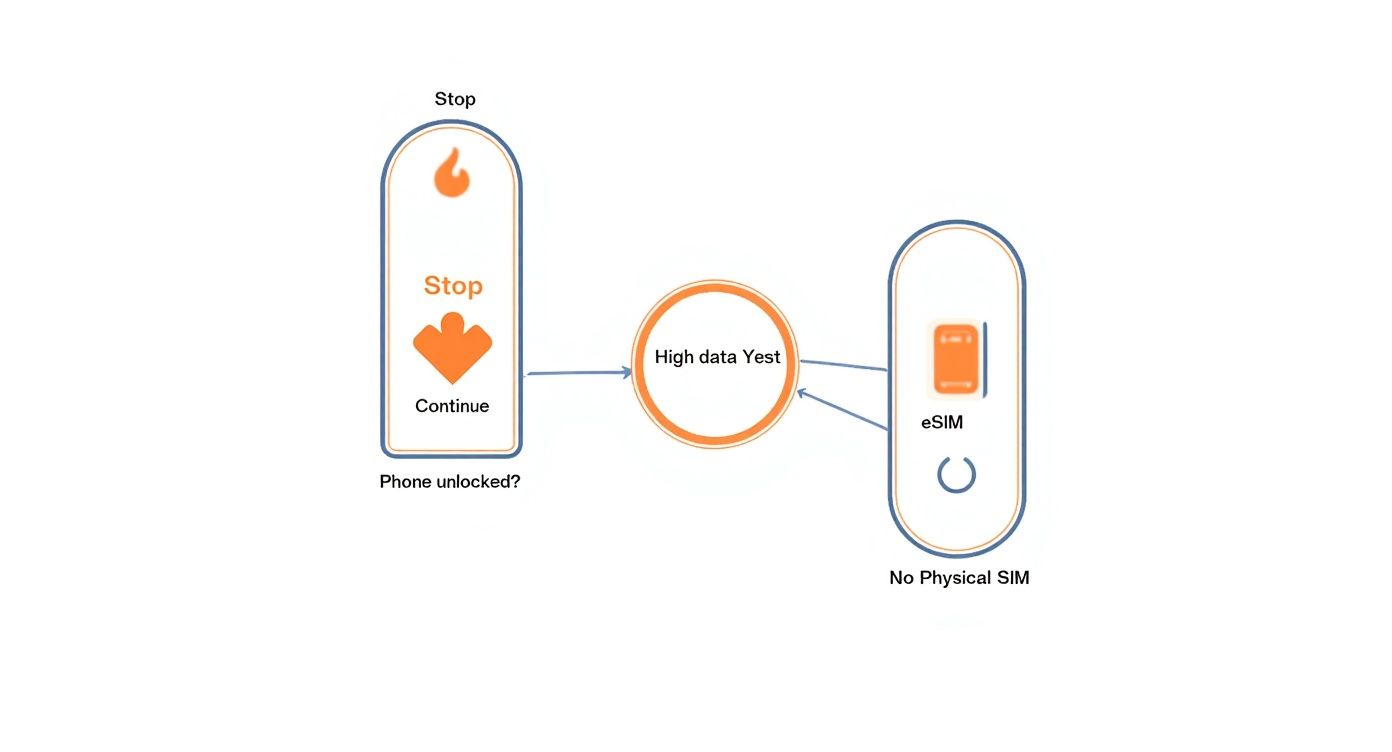
This guide shows that once you’ve confirmed your phone is unlocked, the big decision often comes down to your data appetite. For heavy use, eSIMs tend to offer far more flexibility.
You’re off to Rome or Prague for a long weekend. You know exactly what you need: reliable maps to get around, a stable connection for booking Ubers, and enough data to spam your friends with photos and look up restaurant reviews. You don’t need a huge 50GB plan, but being offline is simply not an option.
For this kind of trip, a small, flexible eSIM is unbeatable.
Your itinerary is packed: meetings in Frankfurt, a conference in Amsterdam. For you, the non-negotiables are high-speed 5G data, absolute reliability for video calls, and the ability to use your phone as a mobile hotspot for your laptop. Downtime is a deal-breaker.
A business trip demands more than just connectivity—it requires performance. Your focus should be on providers that guarantee 5G access where available and have clear, unrestricted tethering policies.
You’re settling in for the long haul, hopping between countries for a month or more. You’ll be working from cafes in Lisbon and co-working spaces in Berlin, so you need a chunky, cost-effective data allowance that doesn’t disappear after two weeks. Value and volume are everything.
You’re travelling with your partner and kids, which means you’re basically a mobile IT department. The kids need their tablets on long train journeys, and everyone needs to stay connected. The goal here is a single, shareable pool of data through a mobile hotspot.
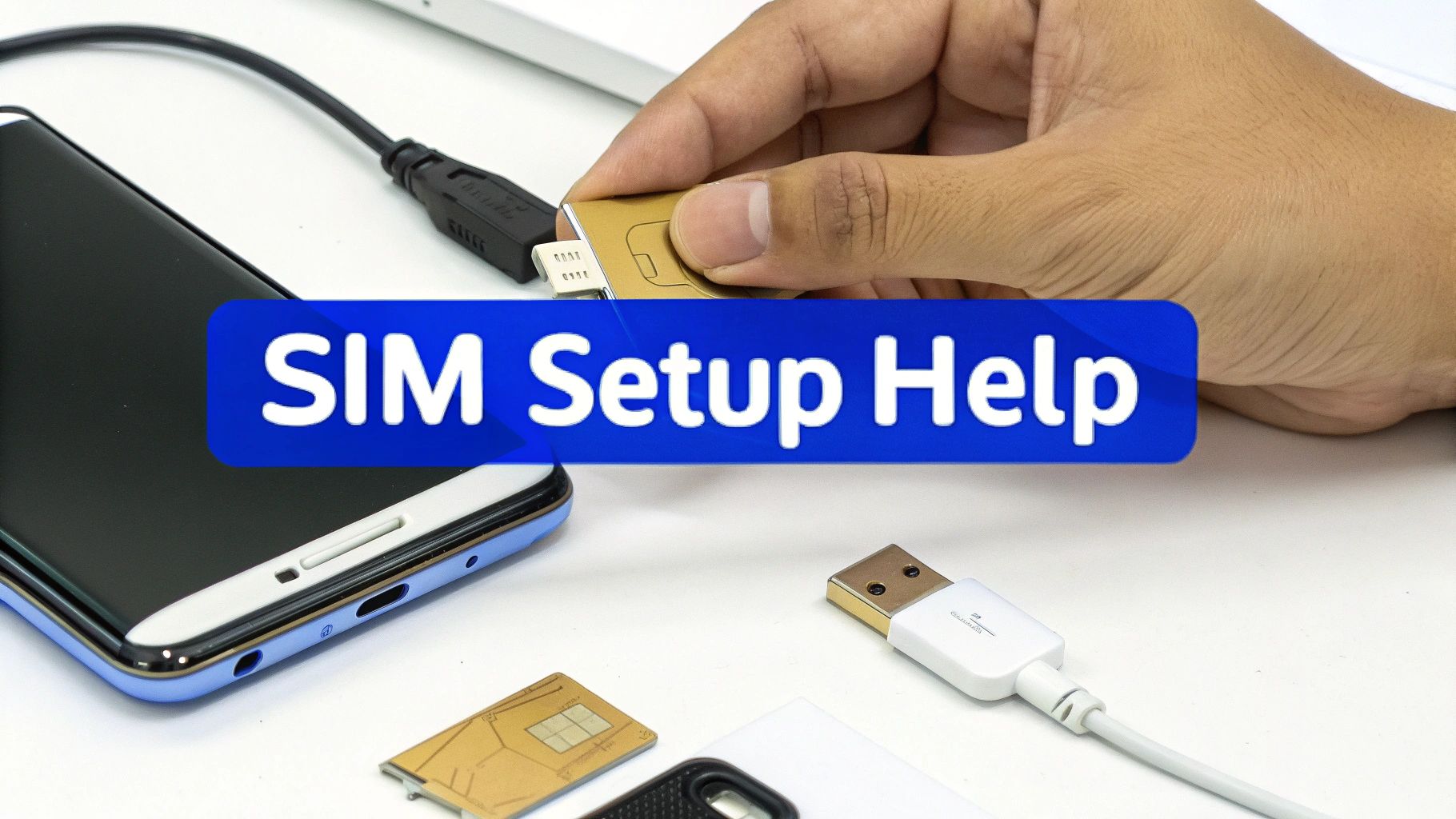
So, you’ve picked out your European travel SIM. Great! Now for the final step: getting it to work. A smooth activation means you’re connected the second you land, dodging that all-too-familiar airport panic when you can’t load a map or book a taxi.
Whether you’ve gone for a modern eSIM or a classic physical card, the setup is usually pretty simple. Still, knowing the right steps—and having a few troubleshooting tricks up your sleeve—can be the difference between a seamless start to your trip and a frustrating one.
Let’s walk through exactly what you need to do for both SIM types and how to fix the most common connection problems you might run into.
Activating an eSIM is a refreshingly digital process. The best part? You can do it all from home before you’ve even packed your bags, which completely eliminates any on-arrival stress.
Just follow these steps to get your European eSIM ready to go:
If you’re using a physical SIM card, the process is a bit more hands-on but still very straightforward. The main things to remember are to handle the tiny card carefully and check your phone settings once it’s in.
The most common mistake travellers make is forgetting to switch on data roaming. Your travel SIM is designed to roam, so this setting must be on for it to work as intended.
Even with the best preparation, things can go wrong. Landing to find you have no service is stressful, but most issues have a surprisingly simple fix. Before you panic, just work through these common troubleshooting steps.
A quick restart is often the magic bullet, as it forces your phone to re-scan for available networks. If that doesn’t work, try heading into your phone’s settings and manually selecting a network operator instead of leaving it on automatic.
For thornier problems, our comprehensive guide offers detailed solutions for when your mobile data won’t cooperate. Find out how to get back online with our troubleshooting mobile data travel guide. This resource covers a whole range of potential issues and their fixes, helping you stay connected.
Even with all the comparisons laid out, you probably still have a few questions buzzing around. Getting these sorted is the final piece of the puzzle, making sure you pick the right SIM for your trip and can travel without a worry.
I’ve pulled together the most common queries I hear from travellers. Here’s some straightforward advice to help you sidestep the usual traps and get the most out of your data while you’re away.
Honestly, it’s almost always better to sort out your travel SIM or eSIM before you even leave your house. Airport kiosks are famous for their inflated prices, pushing tourist-centric plans that give you less data for more money.
Getting it sorted beforehand means you can properly research the best deals, double-check your phone is compatible, and land with a connection ready to go. It saves you the headache of hunting for a local shop when you’re tired after a long flight—the last thing anyone wants to do.
My Two Cents: eSIMs make this incredibly simple. You can buy and install one entirely online from your sofa. That means the moment your plane touches down, you’re connected.
Yes, and this is a game-changer. Most travel SIMs and eSIMs built for Europe let you roam seamlessly across dozens of countries. This usually covers the entire EU and often includes non-EU spots like Switzerland and Norway.
But don’t just assume. Always double-check the provider’s official country list before you commit. Make sure every single place on your itinerary is covered. That one small check can save you from being unexpectedly cut off.
Most prepaid travel SIM providers have made this super easy to handle. If you burn through your data, you can usually just buy a top-up package through the provider’s app or website. It’s a world away from the old days of needing to find a shop for a physical top-up voucher.
Some plans will just slow your connection down to a crawl once you hit your limit, while others will cut you off completely until you buy more. That’s why I always recommend picking a provider with a good mobile app—it makes topping up on the move quick and painless.
Yes, absolutely. To use a physical SIM or an eSIM from another provider, your phone must be carrier-unlocked.
Get in touch with your home network well before you travel and ask them to unlock it. If you bought your phone directly from a manufacturer, like from an Apple Store or Samsung, it’s almost certainly unlocked and ready for any of the best travel SIM cards for Europe.
Ready to travel with seamless, affordable data? With TapSim, you can get connected in over 150 destinations in just minutes. Choose your plan, scan a QR code, and enjoy fair and fast data without the roaming fees. Explore TapSim’s Europe eSIM plans today.

